What Does Search Generative Experience Look Like?
I got access to the limited test of SGE in Google Search, and I’ll share my observations here.
How it shows up in SERPs
When SGE is active for a query, it typically first appears at the top of the results page with a button offering to generate an “AI-powered overview” for your query.
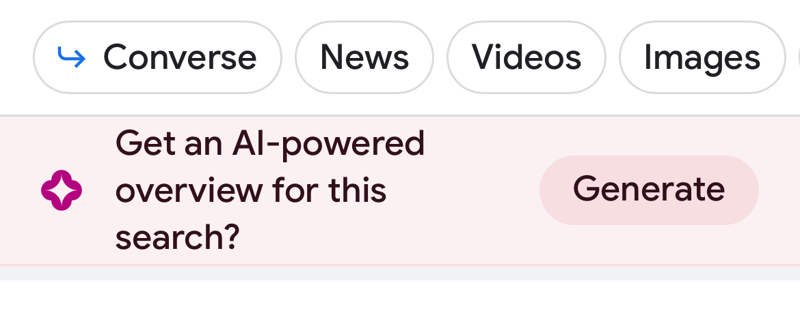
The Converse button, if clicked before entering a search query, opens a dedicated SGE page where you can directly interact with SGE by asking it a question.
If you click the Generate button, a larger space opens above the regular search results for your query with the AI-generated response.
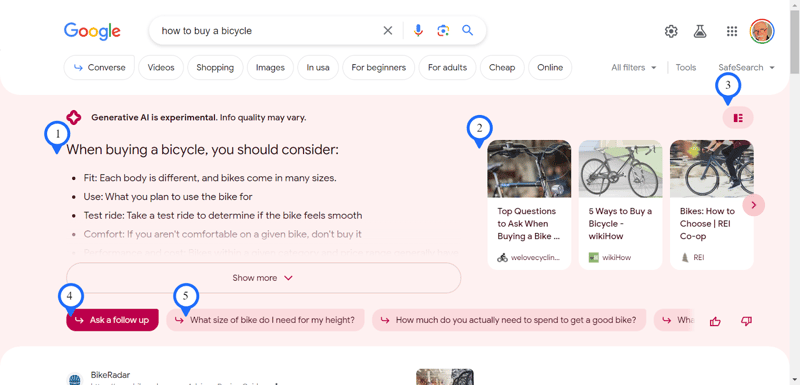
Here are the main components of an informational SGE response:
- The AI-generated text response
- A carousel of selected sites with more information on the topic. Google has told us some of these are likely the sources for the generated response, but not all of them. On mobile, this carousel appears below the generated text.
- A detailed sources icon. Clicking this expands the generated text with more web sources for some of its sections or points. See an example below.
- “Ask a follow up” allows you to ask any question you want about your topic. SGE knows what it’s already told you so can answer in context.
- A carousel of suggested follow-up questions.
The ability to ask follow up questions was touted in Google’s announcements as a standout feature of SGE. They seem to want to position the feature as being most useful for taking a deep dive into a topic.
Here’s what the expanded detailed sources view looks like:

It was widely reported in the days following the release of SGE to those of us on the waiting list that SGE responses stayed out of the way unless the user clicks the Generate button. However, that has not proven to be the case. I’ve noticed that if I start opening SGE regularly, it starts opening on its own in subsequent searches.
Around November 2023, however, Google has been experimenting with a partial expansion view of SGE. Rather than presenting the fully expanded SGE result, it includes a partial view with a «show more» button that you can click if you want to see the full result.
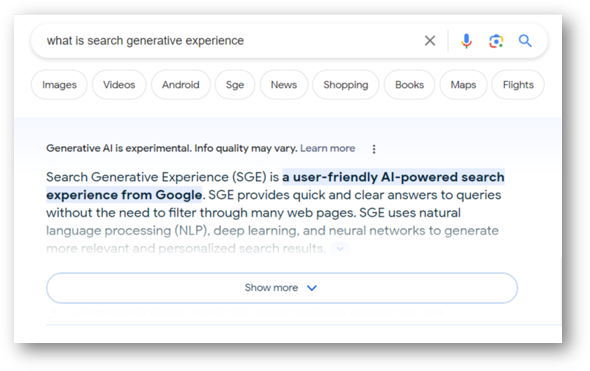
This development could be an attempt to compromise with those who don’t like how far you have to scroll to get to the traditional web results when the full SGE result shows up.
This partial display seems to be coming up pretty consistently now both on desktop and mobile.
Ecommerce in SGE
The first thing to note is when the query has clear commercial intent, Google still puts its sponsored shopping carousel at the top.

The product links in the generated response though are somewhat unique, not matching entirely with either Googles sponsored or organic shopping results.
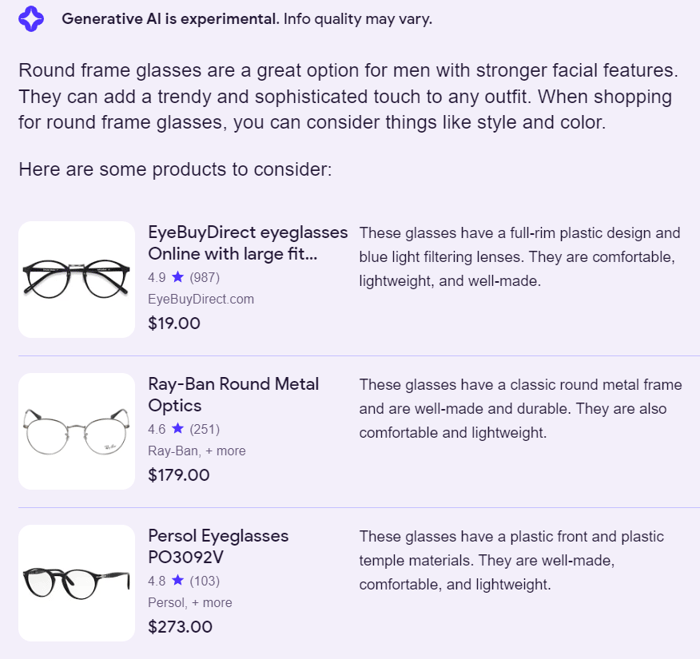
What’s more, , “Google seems to pull these product attributes from written reviews on websites, which is quite stunning because Google turns unstructured into structured data” (emphasis mine).
However, unlike the traditional product listings, these suggested products are not tied to a particular retailer. Instead, when you click on one it opens a sidebar with further filters and multiple buying options.
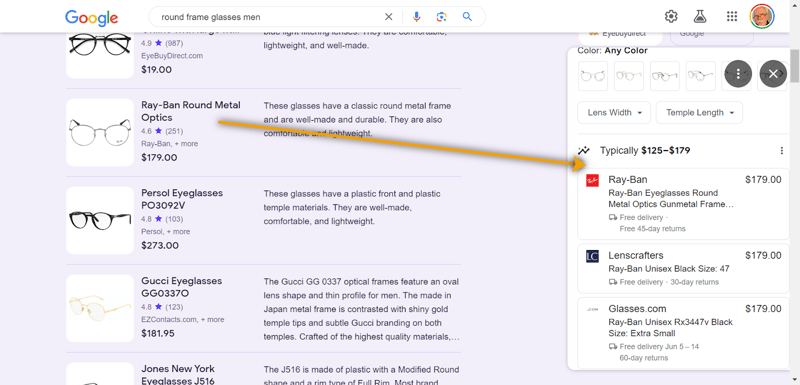
And for local shopping results, SGE brings back the Five Pack!

UPDATE: As evidence that Google is actively adjusting and tweaking SGE, I did the same local search a day later and did not get offered an SGE result like I showed above. On some other local queries I did get an SGE result, but without the map pack formatting.
Shows More Often Than Predicted
One of the first things I noticed after getting access to Search Generative Experience was that it shows up for a lot more queries than I thought it would. Like many other SEOs, I had assumed it would only be used for more complex, longer tail queries where a more complex and nuanced answer might be warranted.
But I’d estimate it shows up for more than 90% of my searches, even in many cases for YMYL (Your Money/Your Life — sensitive topics such as finances and health). For example, this response to the query “do I have cancer?”
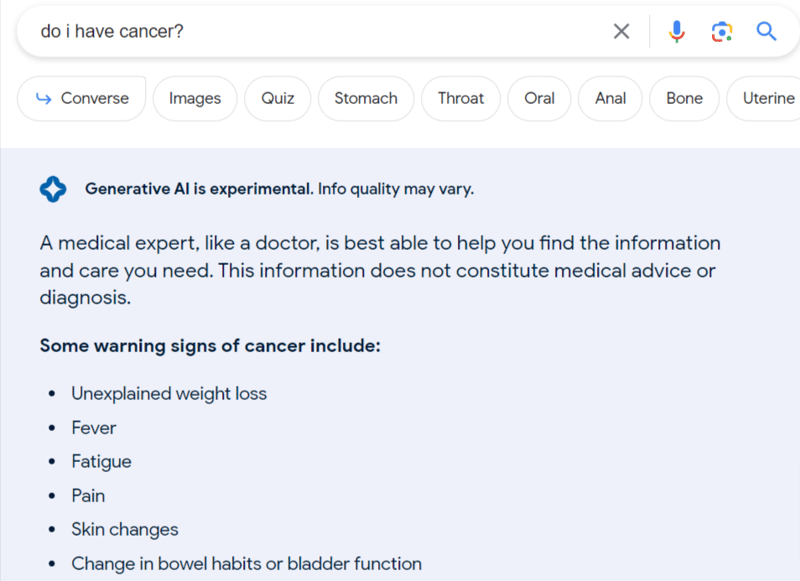
Note though that there is a disclaimer at the beginning of such a response that goes beyond the stock disclaimer at the top of every SGE response.
Potential challenges and limitations of SGE
Despite its promising innovations, the Search Generative Experience (SGE) is not without potential challenges and limitations. These challenges exist on several fronts, from technological constraints to disruptions in organic search results, and even potential issues related to user trust and accuracy of AI-generated responses.
A critical challenge lies in the inherent limitations of generative AI technology. While AI has come a long way in mimicking human intelligence, it still lacks the nuanced understanding and contextual interpretation that a human brain can offer. This limitation can result in inaccurate responses or failure to disambiguate complex queries. For instance, in a test of 30 queries, SGE declined to provide a response to 11 cases and provided inaccurate responses in others.
Google acknowledges these challenges, stating that the quality and accuracy of responses may vary and that the technology occasionally fails to generate useful information for certain queries. Despite the continuous fine-tuning and optimization of the SGE, the reliability of AI-generated responses remains a hurdle that needs to be addressed. Hence, users are often advised to scrutinize the information provided and cross-verify with other sources, especially when the information is critical or professional in nature.
Another key concern is the impact of SGE on organic search results. As AI-generated answers appear above traditional search results, the visibility of organic results might get reduced, potentially leading to decreased clickthrough rates. Moreover, the sources chosen by SGE do not always align with the top organic search results, raising issues over the fairness of source selection and the potential bias of AI algorithms.
Consumer trust and transparency are other significant challenges that SGE needs to grapple with. While SGE often cites the websites it used to generate the answer, the manner in which it pulls information from multiple sources and synthesizes it into a single response raises questions about transparency and originality. Also, with the increasing concerns about consumer data and privacy, Google’s use of AI in manipulating search results may be viewed skeptically by some users.
Moreover, the current availability of SGE (at the time of writing) is limited to users in the US and only in English. Expanding the capabilities of the generative AI language model to cater to multiple languages and cultures is another essential challenge that needs attention.
In summary, while SGE represents a significant leap forward in search technology, it also poses several challenges and limitations that need to be addressed. Addressing these challenges is crucial for the successful wider roll-out of the technology and making it a reliable and valuable tool for users globally. As SGE continues to evolve, so will the strategies to overcome these limitations and provide a more seamless and enriching Search Generative Experience.
Specific impact for SEO:
1. Search queries will change
Looking at how users engage with chatbots and the examples and demos used at the IO conference, it’s clear that user search behaviours are likely to become much more conversational and longtail as users mix query upon query as they engage with the search chat.
This will naturally impact how we deliver keyword research and understand user demands across our clients’ industries. In our view, keywords are likely to remain significant. Still, they will continue evolving as users adapt to new search methods and products within search platforms. There are no firm plans on how Google are going to share updated insights however we expect them to announce it after launch.
What we’re doing:
In the short term, we’re focused on closely monitoring which search queries are triggering SGE. We track over 1 million keywords daily across our clients, spanning 22 markets and many industries. This will give us data to assess the markets, industries, keyword groups and search intent where SGE is being rolled out.
We plan to ensure our SEO dashboards are updated and insight from this data analysis is given to our clients so we can adjust SEO tactics where needed.
In the mid-to-long term, our focus for clients will remain centred around their customers, using keywords to understand search demands and trends. We also believe that moving away from individual keywords and focusing on topics, positioning our clients as experts providing rich, high-quality, helpful content will be needed to maintain visibility in Search Engine Results Page (SERPs).
To support this, we will be ensuring our reporting and keyword tracking are grouped into topical entities so we can better align with how Google is structuring its search results in SGE.
We are working closely with our tool partners, including GetSTAT, to ensure our keyword reporting reflects this update so we can capture changes once they start happening.
2. Click-through Rate (CTR) will be impacted based on the evolving SERP structure
This update represents a significant change in how Google displays search results to users and inevitably we will see less traffic as the number of 0 click searches increase. Whilst changes to SERP updates are nothing new, this change has the potential to dramatically impact results and search behaviour. We expect traditional listings to be pushed further below the fold, reducing CTRs where SGE is present.
What we’re doing:
Our SEO teams will continually monitor the CTR performance of our client’s websites. We have a live CTR tracker bespoke to clients which looks at query type and their avg. CTR performance, so anything that increases or decreases will be flagged.
3. Matching content format to query will become more important
With the introduction of ‘Perspectives’, brands are going to see different formats of content work better for different queries. Want to drive traffic to your new kitchenware products? Instead of a typical ecommerce page, which is boosted with conventional SEO metrics such as links, technical setup, content depth and so on, we will start to see social based content such as TikTok or YouTube Shorts appear more. This brings different ranking mechanisms into play, such as social engagement and authorship. Marketing your product has never been so important!
In consequence, more content variety will need to be produced and your PR, Social and SEO teams will be required to connect into a single approach. Your ability to nail the search intent will be crucial so test, test, test whilst you move forward in this new world.
What we’re doing:
We are already monitoring content type by performance. If new trends emerge, we will share and include them as part of our testing programmes. We also have a multi-faceted content studio to help brief, guide and produce a range of content formats for our clients to test with users.
What is a zero-click search?
A zero-click search means that users get answers on the search engine results page without clicking on links — by reading snippets, browsing headlines, or clicking on maps and local listings. 2022 data from SEM Rush shows that about half of Google searches were zero click, and that this has been trending up over time. Now genAI — or the threat of genAI-forward competitors — has given Google a catalytic push forward in its shift towards more zero-click searches.
Google is still the dominant search engine, and they’re testing using generative AI to answer search queries. If you haven’t seen it yet, you can request access to it in Google Search Labs, and you should start familiarizing yourself because it will change the future of search.
What is SGE? Introducing the Search Generative Experience
So, what exactly is SGE, and how does it work? At its core, SGE leverages advanced machine learning algorithms and natural language processing to generate dynamic search results tailored to individual user queries. Instead of displaying static links and descriptions on the SERP (Search Engine Results Page), SGE generates diverse content formats, such as interactive widgets, videos, images, and more, directly on the search page. This enhancement allows users to access relevant information and answers without even needing to click on a specific result.
It’s important to note that as of its launch in May 2023, SGE is still in its testing phase. Google is actively collecting feedback from users to refine and optimise the experience before a full-scale rollout. This ensures that SGE provides accurate and useful information to users while addressing any potential issues or biases that may arise during the testing process.
Benefits of Google’s AI Search Generative Experience
According to Google, there are three ways its new generative AI capabilities can make searches simpler:
- Understanding Complex Topics: SGE provides an AI-powered snapshot to help users grasp the key factors and considerations of a topic, such as learning ukulele versus guitar, or the benefits of incorporating a business before freelancing.
- Quick Tips for Specific Questions: With SGE, users can submit specific queries and receive a variety of content from across the web. For example, searching for how to remove a coffee stain from a wool sweater, or how to quickly renew a passport, will provide pointers and options
- Shopping Assistance: Search offers information on products and considerations for various needs. Users can search for specific items like peel-and-stick wallpaper for the kitchen, or a Bluetooth speaker for a pool party, and find important product details, like customer ratings and options to purchase.
Click here to read more on Google’s take on the benefits of its Search Generative Experience. The rollout of SGE is a part of Google’s Search Labs, a new program that opens up features still in the experimental phase to users. To see if you’re able to join the waitlist for Search Labs, click here.
Ethical Considerations and Challenges
Although the benefits for searchers are apparent, some ethical issues arise with SGE. The key idea is that SGE is not designed to replace traditional searches. Its purpose is to supplement them by providing users with quality and context-based information. The good news for people who strive to maintain good SEO practices is that SGE still rewards and favors quality content for providing answers. There are a few other possible concerns and challenges.
Privacy Concerns and Data Protection
Some people are concerned about their privacy and SGE’s data protection. For example, several tech companies have asked how Google plans to comply with strict data protection laws like the EU’s GDPR. At a recent security conference, U.S. officials said hackers have already set their sights on AI systems. If they target Google’s AI system, data from billions of people may be accessible. Google is conducting extensive testing to identify and address these and other data protection issues.
Bias and Fairness Issues
While there is plenty of high-quality information on the internet, there is also information that contains bias. There may be bias related to gender, race, or other types of identity. Since AI learns from large volumes of information, risks still exist for promoting biased information or producing it in answers. Additionally, some programs may be used to create and spread false information, propaganda, or other hurtful information. Google is continually looking for ways to address information bias and fairness risks.
Transparency and Comprehensibility
Google says that it is trying to maintain transparency with SGE. For now, the ads that appear on SGE are still part of regular campaigns. On SGE’s ad slots, they are labeled as sponsored. Also, Google corroborates all sentences in SGE answers with outside sources. Since some other AI tools on the market need a better reputation for consistently producing reliable information, Google is prioritizing transparency. The structure of SGE is designed to make it easy for all people to use and understand.
While SGE presents potential benefits for users, it is still a new concept that requires further research and development to address the risks. Also, there are mixed views on whether SGE’s answers will drive more traffic to high-quality sites or stifle it if readers need to click the source links attached to answers. One thing that users can likely count on is more opportunities for paid advertisements. Remember that Google makes the majority of its billions from ads, and it does not make sense for the company to jeopardize that.
Currently, the only way to get access to Google’s new Search Generative Experience (SGE) is to sign up for a Google Search Labs waitlist; this means you could wait weeks before using it directly.
It will first be accessible in the United States and in English exclusively via Chrome desktop and the Google App (Android and iOS).
How Are SEOs Reacting to Search Generative Experience?
I follow several hundred professional SEOs across Twitter, LinkedIn, and a number of private search forums.
The reactions to SGE in this sample of people who either, like me, have beta access, or who have reviewed our sharing of the experience, is mixed, but has been skewing towards unimpressed to outright negative.
In response to such feedback, the stock answer of Google’s Danny Sullivan has been to reiterate that SGE is an experiment, still in its infancy, and that they appreciate and are listening to all feedback.
It’s mostly “Meh.”
The most common criticism of Search Generative Experience is that most of the answers are underwhelming. That is, they don’t often rise above the kind of rudimentary content that might be expected from a copywriter hired on Fiverr.
In many cases it simply produces bullet lists without much detail. Asking a follow up question often provides more detail, but nothing that anyone would mistake for expert-level content.
At an extreme, some are accusing Google of creating content on a quality level that Google itself penalizes sites for. Some have even called it Google’s “content farm.”
No analytics
Many SEOs worry whether Google will share any data about SGE results, in particular impressions and clicks on pages featured as sources or follow-up material. This fear seems warranted since Google has been reluctant to share such data on other SERP features.
Sites featured, but will they click?
While SEOs were relieved at first that Google did include clickable links to website pages relevant to the topic, they noted that only a very few are easily visible. You have to scroll the carousel or click the detailed sources button to see more, but how many users will know or be prone to do that?
Furthermore, it is unclear how these sites were chosen. Often many of them match the top-ranked results in the regular SERP for the query, but not all of them are. It is clear that SGE is using its own algorithm to select its recommended sources.
As of November 2023, Google has started testing out (at least on mobile so far) auto-expanding the sources for SGE results. This is more of a featured snippet-like result since the user doesn’t have to tap to see your site as a source, giving your content a better chance of getting clicked.
Plagiarism
The most extreme criticisms of SGE, however, center around many examples where it appears to have lifted entire passages of text directly from websites, with attribution that might be unclear to the average user.
In this example, shared by Rebekah Edwards on Twitter, you can see that the opening bullet list is identical to the text in the featured snippet below it, meaning that it was taken from the Rejuvenation Dentistry page linked in the featured snippet.

Google Search Liaison Danny Sullivan explained that the first of the link tiles in the carousel is the source of the quotation, but Edwards and others retorted that, unlike a featured snippet, the source is not evident to the average user, nor is it even clear that this is text completely copied from a third-party site.
Some are calling this outright content stealing and plagiarism.
These critics note that Bing’s AI chat in search, in contrast, lists sources like footnotes in the text itself, making clear where each piece of information came from.
It strikes me, as someone who has made extensive use of ChatGPT and other generative AI tools, that these SGE responses don’t even look like true generative text.
Recommended Reading: Cracking the Code: 5 AI Strategies to Apply in Enterprise SEO
Generative AI, though trained on outside content, is supposed to create an “original” response by generating its own text based on its ability to predict the next most likely word (actually, token, which can be a group of words).
But in many responses, SGE seems to just be taking clumps of text whole cloth from several sites and piecing them together.
Here’s an example from Cyrus Shepard on Twitter. When asked “how to boil eggs,” SGE gave a nonsensical, self-contradictory answer that Shepard calculated would have you cooking the eggs five separate time for 60 minutes of cook time!
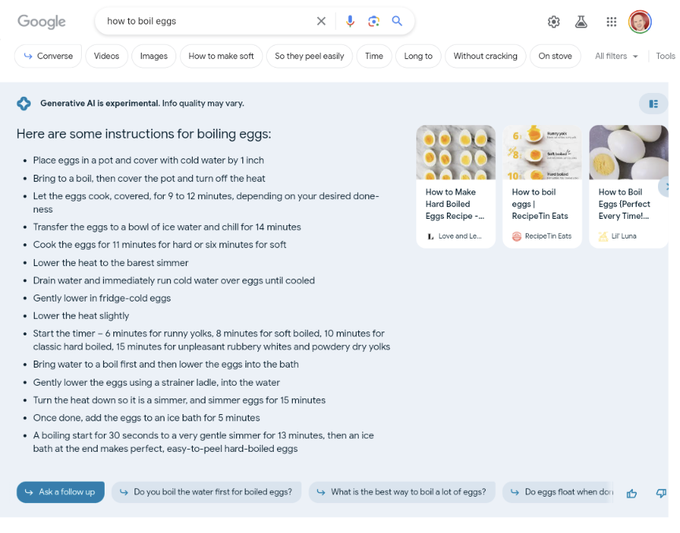
When you click through to the linked sources, it’s obvious SGE just grabbed the instructions from several of them and threw them together.
Curiously enough, this experience does not match what we were shown in the demos for SGE at Google I/O, which seemed to have more sophisticated generated responses.
Specific impact for paid search:
Google’s announcement this week was focused largely on changes to the search experience. From an ads point of view, the details shared were notably brief: Google confirmed that search ads will continue to be a core part of the search experience; they will be positioned in dedicated slots on the SERP; and that they will still be clearly labelled as ‘sponsored’ so that users can differentiate between paid and organic content.
While the announcement was light on details, with search ads representing such a significant portion of Google’s revenues, evolving its ad products to make the most of SGE will clearly be a key focus for Google moving forward. We expect to hear more on this over the coming months (potentially as soon as the upcoming Google Marketing Live on 23rd May). In advance of any concrete announcements, our recommendation to advertisers is to focus on the following areas:
1. Take advantage of Google’s latest, AI-driven products
SGE is geared around using Google’s large language models to better understand user intent, and serve relevant content in response to this. This fits naturally with a number of Google’s key search ads products, most notably Performance Max with its AI-driven optimisation across media platforms; and the revamped Broad Match, which could benefit from the additional signals with chat-style inputs in differentiating between user interactions with commercial and non-commercial intent.
2. Maximise relevant data signals
One of the examples where Google highlighted the potential benefits SGE can bring to users was in providing relevant product recommendations based on specific criteria (e.g. ‘best bike for a 5-mile commute with hills’.
While we don’t know exactly how Google might determine which product ads to serve alongside any Generative AI responses to such queries, we would expect that the amount of specific, relevant information provided alongside any products will be critical in any such decision.
This suggests that ensuring you have robust, accurate and comprehensive data feeds featuring high-quality product titles and descriptions will be more important than ever for advertisers wanting to make the most of Google’s SGE.
3. Keep a close eye on your core KPIs
While in beta, Google has confirmed that we won’t be able to see any kind of data split between ads served against queries where an SGE has been enabled and a ‘regular’ search experience. This will make it hard (at least initially) to pinpoint any SGE-triggered changes that might occur to key indicators such as CPCs (Cost per Click) (for example, if competition spikes against users with highly-targeted queries) or CTR (which may be affected if ads are pushed higher or lower in the SERP by the inclusion of Generative AI snippets).
As always, the critical thing for advertisers is to keep a close eye on how these metrics, core KPIs such as sales and ROAS (return on advertising spend), vary over time and to optimise your activity accordingly.
What we’re doing:
Our Paid Search teams are already working with clients to ensure they are leveraging Google’s suite of AI-products, maximising relevant signals via data feeds and conversion tracking, and continuously measuring and optimising performance. We’re also partnering closely with Google to ensure our clients get the best possible support and opportunities to test any new ad product releases as the search experience evolves.

